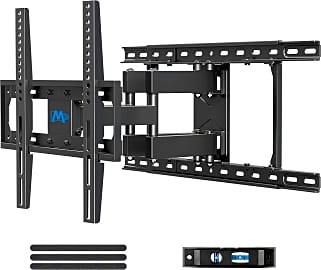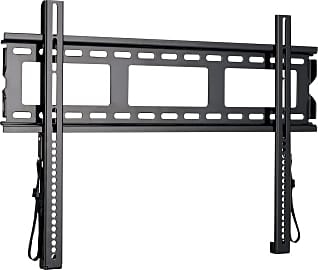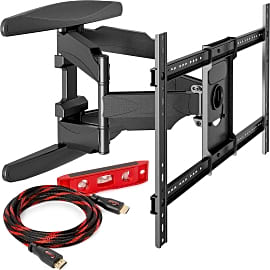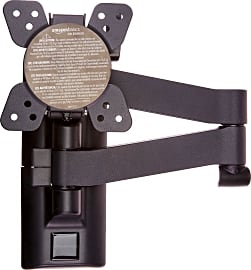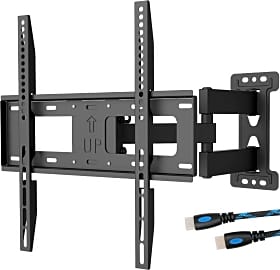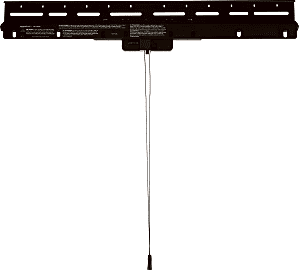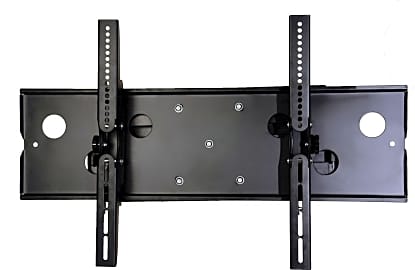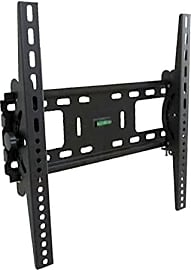The 10 Best TV Mounts

This wiki has been updated 41 times since it was first published in March of 2015. If you have recently invested in a flat-screen TV, you likely don't want to risk the possibility of it being knocked over or damaged. These mounts keep televisions permanently fastened to the wall and at the ideal viewing height, while freeing up table space. We've provided a variety of sizes and styles, and included some adjustable options that allow for easy repositioning. When users buy our independently chosen editorial recommendations, we may earn commissions to help fund the Wiki.
Editor's Notes
January 08, 2021:
There are plenty of things to consider when choosing a suitable mounting bracket for your TV, such as will it sit flush to the wall, as is the case with the Sanus Flat and the Cheetah APTMM2B, or would you prefer it to be adjustable as seen with the Universal MI-310B and the Wali Full Motion. Also, there is the size of the TV, as smaller sets will be fine with a single-arm design such as the AmazonBasics Articulating, whereas larger, heavier televisions will need a more robust system such as those found on the Mount Factory Full Motion and the Echogear EGLF2, which can accommodate screen sizes of up to 86 inches.
In our latest update, we replaced the popular Mounting Dream MD2380, with the upgraded Mounting Dream MD2380-24K, which can now carry a wider range of TV sizes, and features an improved mounting bracket that is compatible with 16-, 18-, and 24-inch stud spacing. We also added the Amazon Basics No-Stud which is specially designed for situations where it's not possible to get a solid fixing in a wooden stud, however, this one does require a certain level of competence in order to install it securely.
May 23, 2019:
Due to weak bolts, we found that the VideoSecu Dual is a potential safety hazard, so we opted to remove it from the list. We replaced it with the Echogear EGLF2, which comes with heavy-duty brackets and sturdy hardware for a high level of stability once assembled. This model is strong and solid to a fault; a few users have minor gripes about its weight, but as it’s rated to hold up to 125 pounds, a little heft is to be expected.
For all the benefits it provides (an impressive load capacity, flexible tilting and extension capabilities, a bonus bubble level), the Mount Factory Full Motion is a great value. Users appreciate a simple installation process and reliable sturdiness once it’s set up. We moved this item up in the list.
We updated the listing of the Wali LCD to reflect the latest model, as the original item on the list had become outdated. This version appears to be on par in performance and value with the older item, as users highlight its simplicity, range of motion and affordability. It offers a few different styles to accommodate anything from a large tablet to a 55-inch flat screen.
Special Honors
ModernSolid Mounts From a compact, fixed model that sits flush on the wall to variety of universal units sized for different TVs, these ModernSolid options are discreet in appearance and offer straightforward adjustment mechanisms. The tilting model has five different angle settings. modernsolid.com
Mounted Against All
Instead of all that stress isolated in two or four points, these mounts distribute it across bars or plates that abut your wall for leverage.
I don't know if I could imagine a more miserable scenario: You've just pulled the popcorn out of the microwave and mixed a little vanilla extract into the Coke. You're all set for movie night, and the family couldn't be more excited. You've also just bought and hung a new 60" 4K TV with 3D and every other bell and whistle available to you. You hit play, and the cheap mount you selected fails, sending your brand new television crashing to the floor.
Each of these TV mounts works rather simply, though there are subtle differences from each to each, giving some a slight advantage over others. The key here in preventing a nightmare like the one above is weight distribution.
When you walk on fresh snow in your boots, your leg sinks through the light snowpack almost immediately. If you have a long distance to travel, all of this extra trudging is liable to tire you out before long, and your legs will be significantly colder for your effort. If, however, you were to employ a snowshoe, which is like a big tennis racket strapped to the bottom of your boot, your weight would be distributed over a larger area, and you would sink a heck of a lot less if you would sink at all.
If you think of the weight of your television in similar terms, it's the job of the TV mount to distribute the stress that your heavy TV would put on a pair of screws anchored in the wall. Instead of all that stress isolated in two or four points, these mounts distribute it across bars or plates that abut your wall for leverage. Sometimes your TV mounts directly to these bars or plates, and sometimes it mounts to an articulating arm so you can perfect its positioning in the room.
Wrestling With The Arm
Essentially, there are two types of TV mount for you to consider, although there are aspects of each that will help you further narrow down your selection to just a couple. One style mounts your TV nearly flush against the wall with little to no articulation. The other provides you with a kind of flexible arm for maneuvering and positioning your TV.
That extra strength will give you much needed peace of mind, so you can focus on what's on the screen instead of what's going on behind it.
When flatscreen HDTVs first hit the market, I wanted nothing more than to recreate the mounting styles I saw in all the commercials, which positioned the units flush against the wall, and somehow managed to run them without any visible wires. At some point in the future, a combination of induction power, Bluetooth connectivity, and high speed wireless casting will make this kind of set up pretty effortless, but for now, it still requires that you drill a few holes in the wall and carefully run your wires through them to achieve this futuristic effect.
That kind of setup requires a flush-style mount, and you will quickly see that the primary difference among these mounts comes down to an aesthetic choice: where in your room do you wish to mount your TV and how do you want it to look?
The advantage of the flush mount is greater security compared to the more complicated articulating arms. Those arms have a lot of moving parts, which, in theory, decrease their stability, as the arms are only as strong as their weakest points. If your ideal mounting point is higher in the wall, however, most flush-mount systems sit your TV flat against the wall, which isn't great for the viewing angle, and is especially damaging to the 3D experience.
The articulating mounts, by contrast, allow you to mount your TV anywhere from the highest point on the wall to the most awkward corner of the room without any concern for how it will affect your viewing experience. In addition to their slight sacrifice in stability, however, you'll also see more of the mounting hardware in an articulating design, which detracts from that free-floating TV image that flatscreens have the potential to offer.
Whichever style suits you best, make sure you err on the side of a higher weight class than you might need, so long as that doesn't result in the mount itself protruding from the around the edges of the TV frame. That extra strength will give you much needed peace of mind, so you can focus on what's on the screen instead of what's going on behind it.
Flatscreens Take Over
Flatscreen mounts have been around for as long as there have been thin LCD and plasma TVs. Both of these screen types emerged in the early 80s, but, like the OLED TVs of today, they were prohibitively expensive, which kept them out of the home television market and exclusively in the computing sector for years.
LCD technology beat plasma to the consumer television market, with a portable LCD TV by Casio hitting the market in 1983. It wasn't until 1988, however, that anyone produced a commercially viable LCD TV for the home, when Sharp unveiled a 14" flatscreen model.
From there, the race was on, and television manufacturers competed like crazy to improve the display while cutting down on the cost. As the popularity of the TVs grew into the early 2000s, so, too, did an industry of attendant accessories absolutely explode. This industry, of course, included the first such mounts like the ones on our list.


